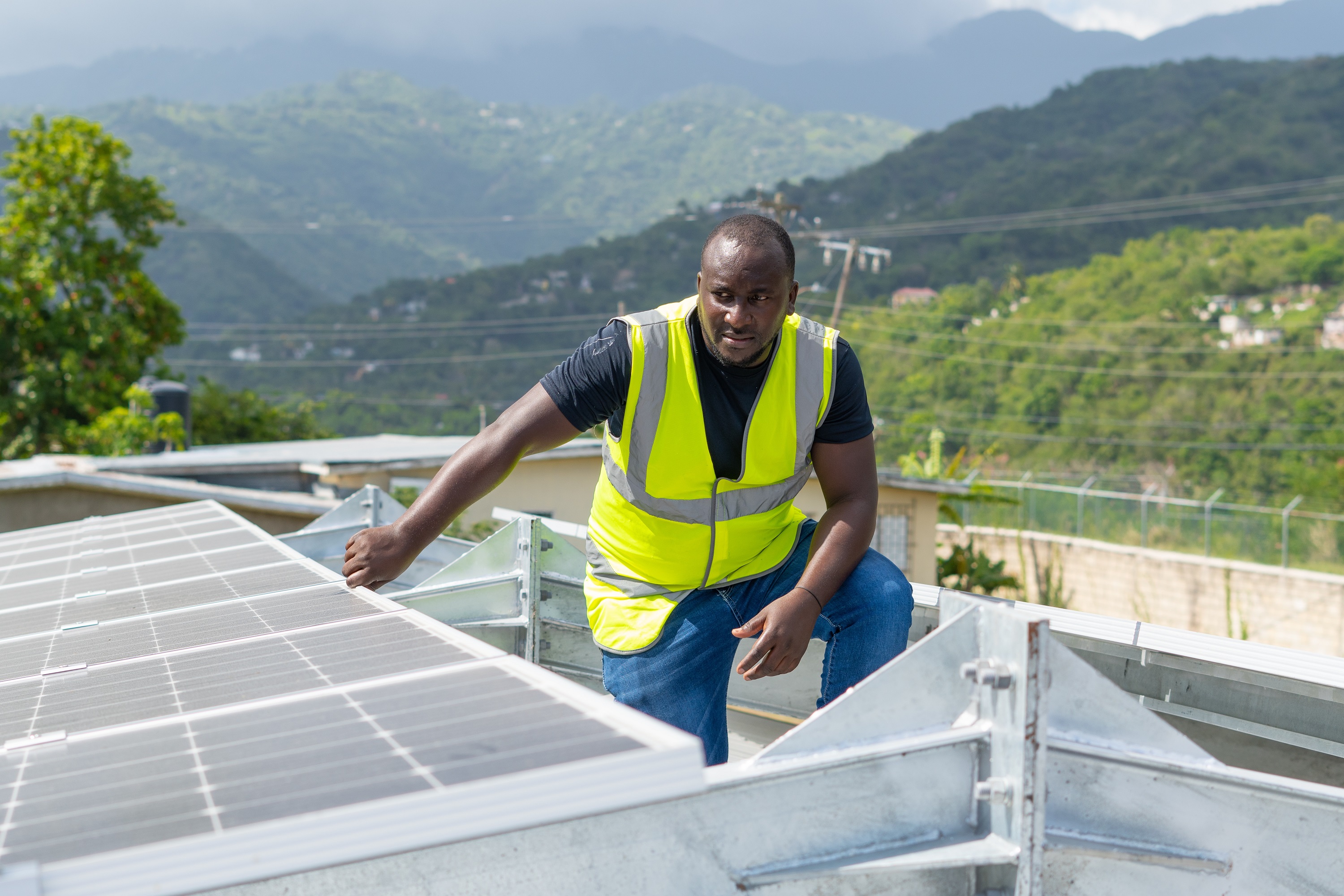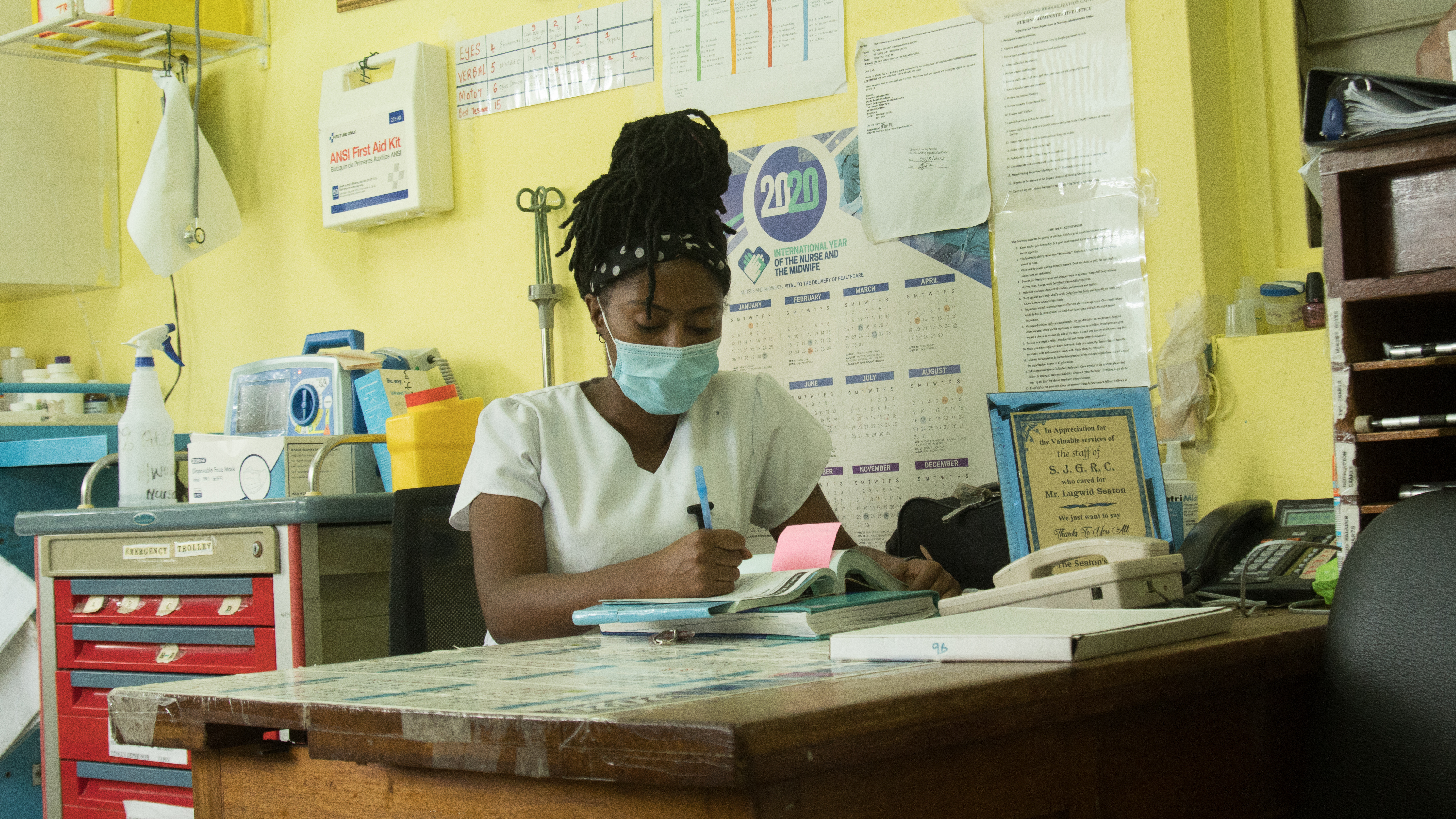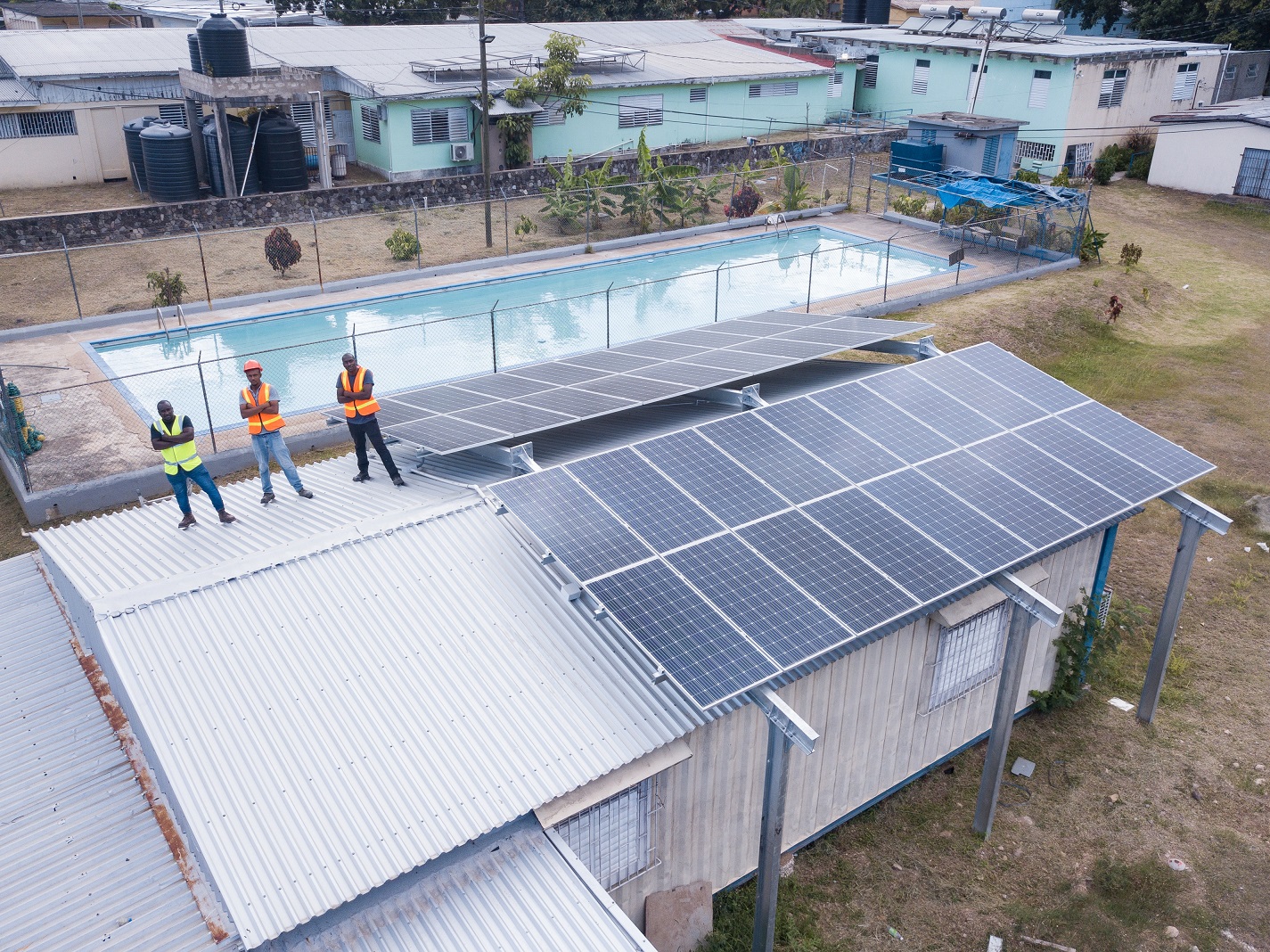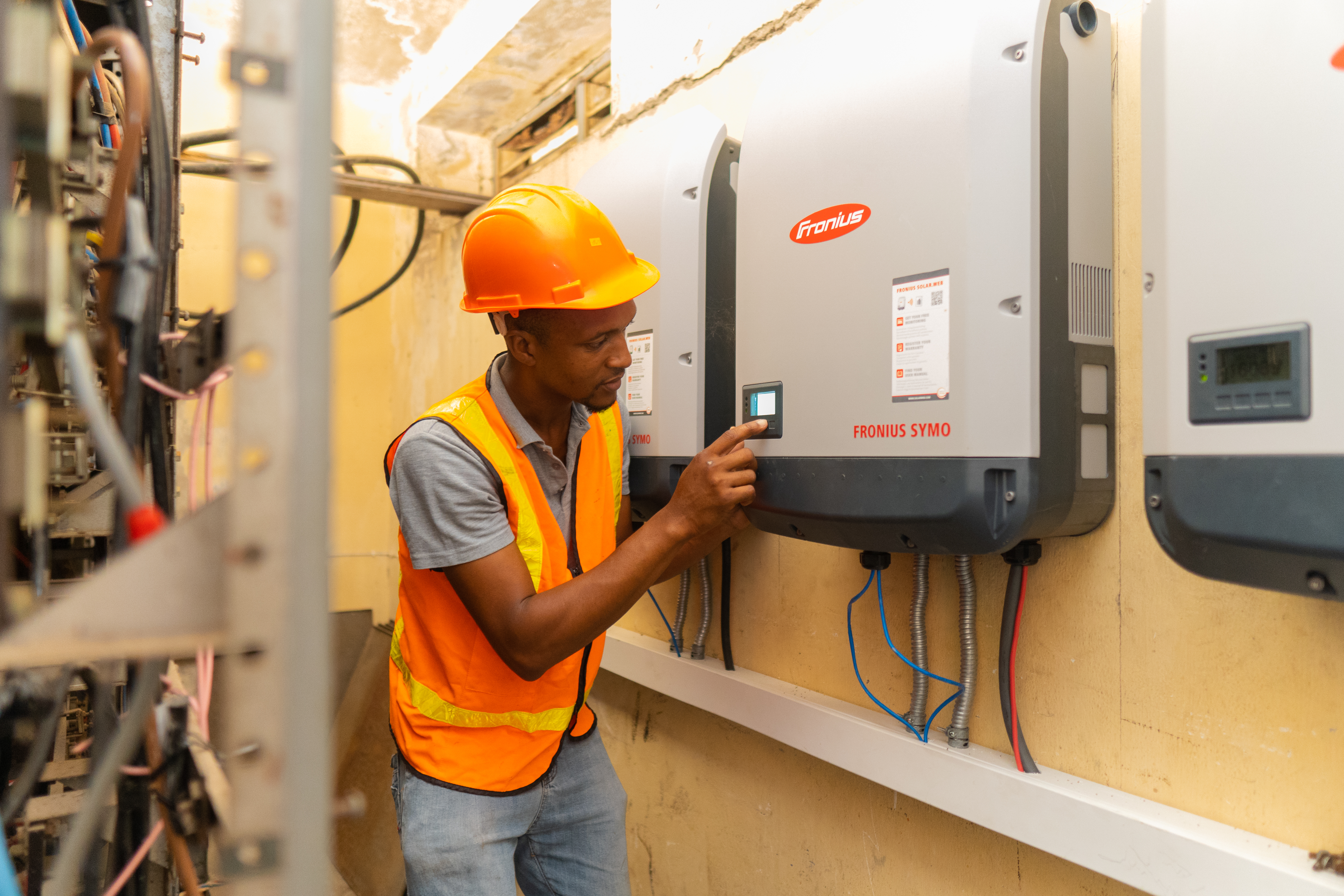Solar energy is helping to cut energy costs & fossil fuels at a 1-of-a-kind hospital for persons with physical disabilities in Jamaica. | Project funded by Global Environment Facility (GEF)
Hospital scores sun-powered success
April 5, 2023


Member of the maintenance team for Sir John Golding Rehabilitation Center and National Chest Hospital inspects the solar panels which help power the Rehab Centre.
UNDP MCO in Jamaica/Talk Up Yout
For 67 years, the only integrated treatment and rehabilitation facility for persons with physical disabilities in Jamaica was almost exclusively powered by fossil fuels. The lone exception was its sun-powered water heaters.
In 2021, the hospital looked again to the sun to energize a wider range of operations. A grid-tied solar photovoltaic (PV) system was installed, with solar panels nailed to the roof of a meeting room, and all incandescent bulbs were switched out for energy efficient LEDs.
Energy needs are significant at the comparatively small Sir John Golding Rehabilitation Centre, established 1954 in response to a major poliomyelitis outbreak. Rehabilitation operations must power equipment and facilities for the treatment of spinal cord injuries, cerebral palsy, congenital deformities, as well as orthopedic conditions and amputations.
Despite challenges including offline lapses in the solar energy monitoring app and increases in fuel charges and inflation which spiked energy bills, emerging data indicates the stellar potential of the solar installations and hints at savings if fossil fuels had remained the sole source of power.

A Nurse at the Sir John Golding Rehabilitation Centre performing administrative tasks in an office lit by LED lights supplied by the project. All incandescent bulbs were replaced with LED lighting.
UNDP MCO in Jamaica/Talk Up Yout
Snapshots of solar power performance
Snapshots of peak performance moments recorded in the online app indicate that the Rehab Centre’s solar system started to generate 1694-kilowatt (kWh) hours or 1.6 megawatt hours in one-month (May 2021), mere weeks after it was commissioned. Nearly two years later, in April 2023, the system was producing 1786 kWh in one month. Just one month later in May 2023, generation had increased to 1925 kWh – that's nearly two megawatt (MWh) hours. App readings prove the solar system had channeled a combined 3.7 MWh of solar power to the hospitals in those two months.
Just one megawatt is enough to power 164 average American homes for one day, says the Solar Energy Industries Association, a USA based trade association. One megawatt can also power an electric car for 3,600 miles (more than the width of the United States); two refrigerators for about one year and two 60-watt light bulbs running 24-seven also for a year, says Eco Watch, an 18-year-old environment news leader from Ohio, USA.
If this level of energy generation remains constant, the solar system will produce 16 800 kWh in 2023, says Yannis Varkas, engineer at Enviroearth, the company contracted to supply, install and monitor the PV system. He says this means the Rehab Centre is on target to generate over 50 percent in excess of the annual 10 000-kWh projected before installation.

Aerial shot of the solar panels which help power the Sir John Golding Rehabilitation Center. Three members of the maintenance team inspecting.
UNDP MCO in Jamaica/Talk Up Yout
"Costs would have been higher without the solar energy"
The Engineer estimates an average monthly production of 1.4 MWh (1400 kWh) of solar energy generated solely by the PV system and says this reflects direct savings of approximately US$400 for the month assessed – roughly the same as 2022.
Varkas projects annual savings at USD 4,800 or just above JMD 720,000, not accounting for inflation and fluctuations in solar energy production relating to sunny or cloudy days. This represents projected savings of close to 1.5 million Jamaican dollars for 2022 and 2023 combined if current trends continue.
Results reflect the impact of the Renewable Energy and Improvement of Energy Efficiency in the Public-Sector project implemented 2016 to 2021 by UNDP Multi Country Office in Jamaica in partnership with the Ministry of Health and Wellness and the Ministry of Science, Energy, Telecommunications and Transport. The project was funded by the Global Environment Facility (GEF) with a US$1.25 million grant.
Sir John Golding Rehabilitation Centre was one of three public hospitals retrofitted with LED and grid tied PV systems. Another three hospitals were LED-retrofitted only, for a total of 5,000 LED solutions installed at six hospitals.
The Centre now has the capacity to generate even more savings by activating net billing with the local light and power company, Varkas points out. This will allow the Rehab Centre to resell energy to the local light and power company in the event of excess supply. Earnings from that sale would also be considered savings attributable to the PV system.
At one other participating hospital, the retrofits reduced carbon (CO2) emissions by eight tonnes over four months in 2021, confirms the solar PV online monitoring app. That’s the equivalent of a car driving 32,316 km (about 20 080 miles). More than 200 trees would have to be planted to absorb that quantity of CO2.
Charges could have been higher without the solar as fuel charges and inflation surged
Senior Medical Officer at the Centre, Dr Rory Dixon confirms increasing fuel charges and inflation have increased electricity bills, and costs would have been higher without the solar systems.
“We normally don’t get everything we ask for in terms of a budget. So, energy savings help us meet the basic demands,” says Dr Dixon. He is now advocating for an expansion of the renewable energy project so energy savings can be channeled into well needed infrastructural development.

Damion Lawrence, Maintenance Supervisor at the Sir John Golding Rehabilitation Centre inspecting the solar panel system
UNDP MCO in Jamaica/Talk Up Yout
Operational efficiencies realized
Maintenance Supervisor, Damion Lawrence is one of two electricians at Sir John Golding Rehabilitation Centre who benefitted from the capacity building of 32 health sector personnel.
The monitoring is now easier because it's all automated, observes Lawrence. This means that the team is able to monitor energy savings remotely using the online platform.
"This facility (Sir John Golding Rehabilitation Centre) uses most of its energy during the day so the grid type would have been the best. We are appreciative of what has been installed here," Lawrence explains. "A lot of times we … supervisors … say we need to do this, and it hasn't been done, but now the CEO and (leaders) are realizing that this is the way to go," he notes.
Health sector takes up 6% of Jamaica's energy bill
Up to 2012, Jamaica’s health sector accounted for six percent of the total public sector electricity bill at a cost of US$10.2 million and 30 gWh (gigawatt hours) per year of energy consumption. In 2021, the Minister of Science, Energy, Telecommunications and Transport Hon. Daryl Vaz projected a 22 percent annual decline in the public health sector bill arising from the GEF investment.
A post retrofit analysis by former UNDP project manager Tenny Daley projected a 22 per cent reduction in the public health sector energy bill as a result of the GEF investment in six public hospitals. A 20 percent kilowatt reduction at Sir John Golding may mean the government is well on its way to achieving this target.
Renewable energy investments in public health institutions should help Jamaica secure its ambitious goal of generating 50 percent of electricity supply from renewable sources by 2030. Up to 2020, about 18 percent of current electricity demand was being met by renewables, according to MSET in a Jamaica Information Service report.
The Rehab Centre's solar energy unit is on target to generate over 50 percent in excess of the annual 10 000-kWh projected before installation.Yannis Varkas, engineer, Enviroearth, the company contracted to supply, install and monitor the solar PV system

 Locations
Locations